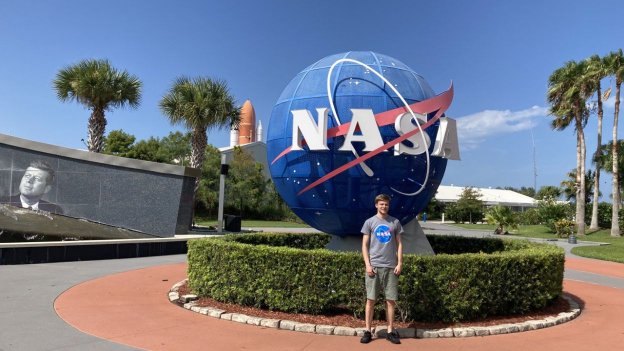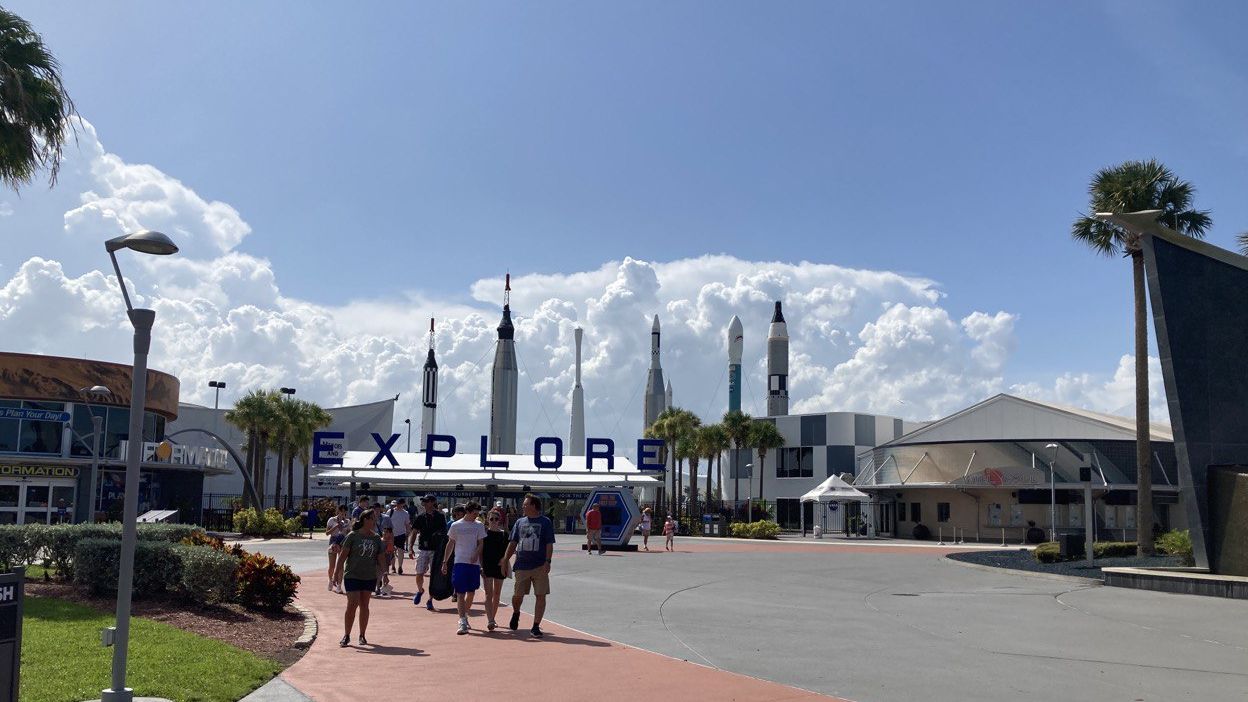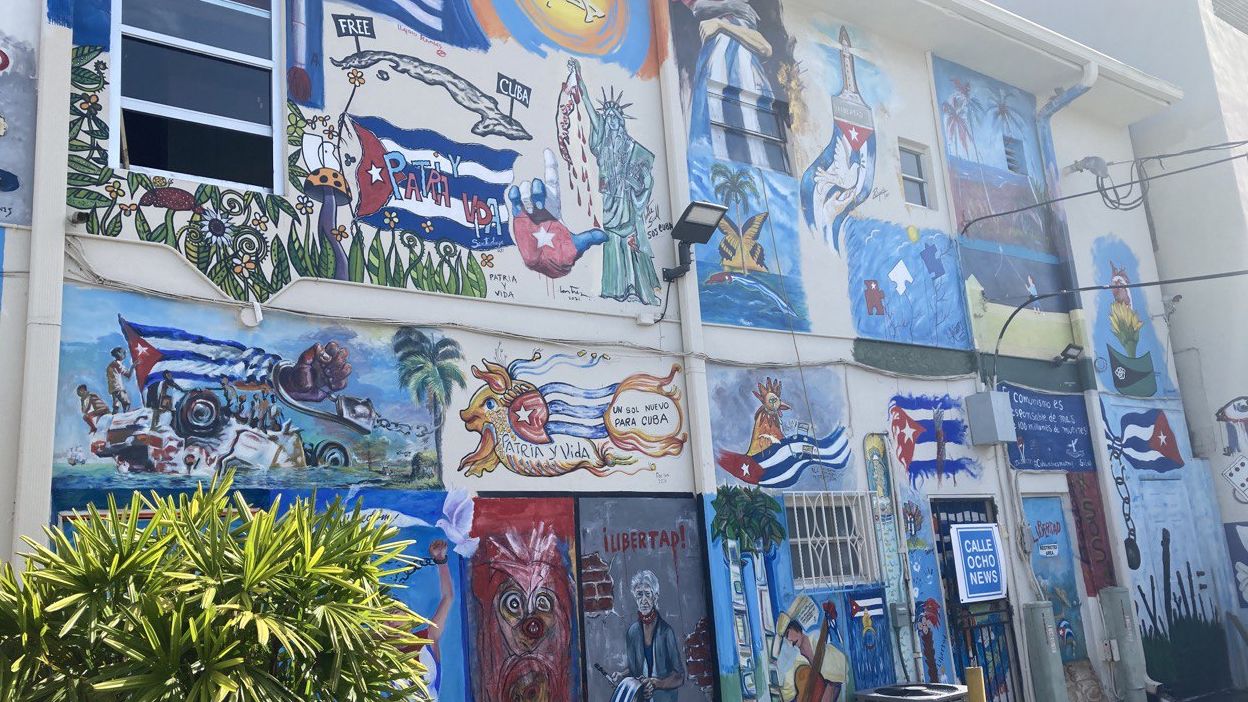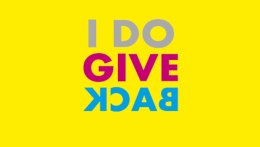Simon Reichert
 Privat
Privat
At the NASA globe in Cape Canaveral, Florida
"The experiences I was able to gain during my research stay in Tallahassee funded by the DAAD-Stiftung were invaluable to me for both my academic and personal development. I would like to express my sincere gratitude to the DAAD-Stiftung and
Dr. Knapp as the donor for their generous support, which made these intercultural experiences possible for me."
Thanks to the funding from Dr. Wolfgang Knapp, the DAAD-Stiftung was able to provide Simon Reichert with a research stay at Maglab in Tallahassee.
Here he reports on his research on the world's most powerful MRI scanner and his time in Florida:
A Knapp Scholarship from the DAAD-Stiftung made it possible for me to travel to Tallahassee, the state capital of Florida. There I was able to use the world’s most powerful MRI scanner to conduct further research for my doctorate on Sodium MRI (sodium magnetic resonance imaging). My work is on sodium imaging, focusing on the triple-quantum signal. This signal in particular promises a non-invasive way of measuring cell vitality. However, it faces hurdles due to the weak signal and a lack of understanding around how it accrues in biological tissue. This is where the world’s most powerful MRI scanner comes in. It is located at the National High Magnetic Field Laboratory (NHML, or Maglab for short), which significantly boosts signal strength. By using this equipment as part of my preclinical research project, I was able to develop new methods of measuring the triple-quantum signal. These make it possible to generate the triple-quantum signal through a different pathway. The molecular environment around the sodium affects this alternative pathway differently. Combining the two pathways allows us to investigate the molecular environment in much more detail. During this work I discovered that the established model did not fit well with the experimental data. I therefore developed a model that includes both faster and slower interactions, making it better suited to describe the biomedical and physical environment. Outside my research work I was able to get to know the country and its culture and make friends.
My working group at Universität Hamburg has been involved in a partnership with researchers at Maglab for several years, and several visits and research stays have already taken place between the two institutions. My Maglab supervisor was among those who came to visit us at the Institute. This made it easy to get in touch and we quickly drew up a plan for my research stay. Fortunately the DAAD-Stiftung approved my funding application, so I was awarded a scholarship which made it possible for me to undertake my research stay.

Privat
The Kennedy Space Center Visitor Complex in Florida
It was regrettable that I had to postpone my research stay several times due to the Covid-19 pandemic, and I arrived in the US four months later than originally planned. Not only was the host institute closed to foreign users, but Covid also caused closures of the responsible departments. However, once I had got over these barriers, things moved on quite quickly. I was sent form DS2019 from Florida State University (FSU) which you need in order to obtain a J-1 Exchange Visitor visa. I was also able to complete form DS-160 at the same time. The J-1 visa is specifically for exchange programmes for limited periods of time, such as those supported by the DAAD-Stiftung. A DS2019 form effectively represents a certificate issued by the US institution approving your participation in the exchange programme. I was then lucky enough to get an interview at the embassy in good time. The interview wasn’t complicated and only took a few minutes. A week later I received my passport back along with my visa. Two weeks after that, I was on my way to the US.
When I arrived in the US I did not have a place to live, so I spent the first few days in an Airbnb. It turned out to be much quicker and easier to find an apartment once I was there compared to doing it online. My rent was $850/month including utilities for one room in a four-person shared apartment, which compared favourably to what other students in Tallahassee pay. Even so, it was in a great location right by the campus, so I didn’t have to rely on a car. That was important to me, as public transport was extremely badly developed – as is the case almost everywhere in the US.
Tallahassee is the capital of Florida and is dominated by the beautiful campus of FSU and government buildings. Apart from that, the city comes across just like you’d imagine any other small American city. Everything is a long way apart and you are very limited if you don’t have a car. The long trip to the nearest supermarket was a particular surprise to me and I tended to underestimate distances in general. The weather was typical for Florida: hot and humid. It was bearable because pretty much every building had air conditioning, but on the other hand, it created a huge temperature difference between indoors and outdoors, which wasn’t always pleasant. When it rained, it really rained, and there were usually storms, too. Luckily, I returned shortly before the hurricane season.
There were plenty of services for international students at FSU, along with student-organised clubs on all kinds of themes. However, the summer semester there is treated like a kind of summer vacation, so there was less going on in general, unfortunately. Nevertheless, I got to know lots of lovely people and made friends. The ‘International Coffee Hour’ turned out to be a particularly good venue for getting to know friendly people. It is organised by students and the Center for Global Engagement at FSU and takes place weekly, with home students and international students dropping in.
Of course I also wanted to see what things were like outside Tallahassee, so I went on day trips. These included the Gulf Coast (where the water was unbelievably warm), national parks and several cities. One trip took me to St Augustine, the oldest continually occupied city in the USA. There I learned a lot about how Spanish colonisers had conquered and settled Florida. In Miami I got the chance to experience the Hispanic influence in this incredibly bright and colourful city at first hand. I also went to Houston, where I visited America’s largest rodeo and livestock show and got a taste of American and Texan culture in its purest form. My personal highlights were the NASA visitor centres at Cape Canaveral, Florida and Houston, Texas.

Privat
Graffitis on Calle Ocho in "Little Havanna", Miami
During my stay I was able to make crucial progress on my research topic, not only because I was able to use the unique 21T MRI scanner, but also thanks to the outstanding support I received from leading researchers. Yet without the generous support of the DAAD-Stiftung this stay would not have been possible. Through my research stay in Tallahassee, which was funded by the DAAD-Stiftung, I gained invaluable experience, both for my academic career and for my development as a person. I would like to say a huge thank you to the DAAD-Stiftung and Herr Dr Knapp, who sponsored the scholarship. Their support was so generous and it made these intercultural experiences possible for me.
As of January 2023. The German version is the original.


